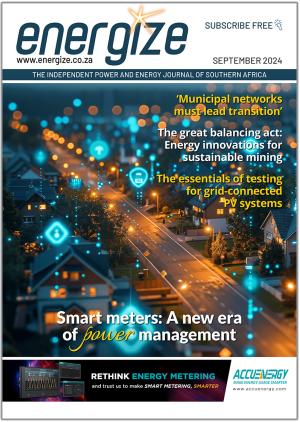Eskom has applied for a price increase of 32,02% for financial year (FY) 2024, with the increase being implemented on 1 April 2023.
In the assumption that Eskom will retain its inclining block tariff methodology, and that Nersa approves this increase, the commonly applied domestic electricity tariff, Homelight 60 A inclining block 1, would increase from 199,72c/kWh to 263,67c/kWh (incl. VAT).
Electricity consumers who are supplied by municipalities may see even higher tariffs. One metro currently charges 175,38c/kWh (excl. VAT) plus monthly service and network charges of R771,29 (excl. VAT) on postpaid; while another metro charges a flat rate of 259c/kWh, for up to 600 kWh, on prepaid.
In a statement published on 15 September 2022, where Eskom justifies its most recent tariff increase request, it says that following a court order issued in July 2022, the National Energy Regulator of South Africa (Nersa) is considering Eskom’s Multi-Year Price Determination 5 (MYPD5) revenue application for FY2024 and FY2025.
In accordance with Nersa’s MYPD methodology, Eskom is required to provide any updates on changes in conditions and environments which impact various cost elements of the revenue requirements. The total revenue as applied for in June 2021 - R335-billion (for FY 2024) and R365-billion (for FY 2025) remains the same. Changes are made within the cost items as required with an off set in the return on assets.
The utility lists key changes from the previous update (January 2022)
- Increases in Eskom primary energy costs – combination of costs related diesel price increase and volume increase
- Removal of arrear debt related costs – in line with NERSA decision for FY 2023, where other customers do not contribute to gap created by non-paying customers
- Removal of carbon tax related costs – due to announcement by Minister of Finance of impending legislative changes to postpone carbon tax liability to beyond FY 2025
- Increases in independent power producer (IPP) costs – mainly due to increased emergency IPP procurement
- Slight increase in sales volumes
- Further reduction in average energy availability factor for Eskom power stations of 59%
The following assumptions have not changed from the original application
- Operating costs
- Depreciation
- Value of regulatory asset base
- Capital expenditure
The price increase being applied for is 32,02% for FY 2024, and the decision will be implemented on 1 April 2023.
The key contributors include
- Depreciation of 10,67% - due mainly to an incorrect regulatory asset base valuation by NERSA in its FY2023 its decision, (substantially in the generation business),
- Eskom primary energy of 7,85% (of which the majority, 6,09% is due only to increase in diesel and fuel oil prices as well as volume increase in OCGT fuel)
- IPP cost increase of 9,05% (due to further energy being sourced from IPPs including emergency procurement)
The price increase for FY2025 being applied for is 9,74% with IPPs contributing 5,39% to this.
In addition, proposals are made for the recovery of part of the incorrectly deducted equity support from FY 2020 to 2022 (under MYPD4) as well as the regulatory account balance decision for FY 2020. These refer to prudent and efficient expenditure being recovered four to six years later.
The Supreme Court of Appeal has ordered that the remaining R59-billion of the incorrectly deducted equity be added to the allowable revenue decisions for each year, starting on 1 April 2023.
R15-billion each in FY 2024 to FY 2026 and R14-billion in FY 2027. The proposal is to allow these recovered amounts to be targeted towards the return on assets for the transmission and distribution network businesses. It also allows for the further migration towards cost reflectivity for the Eskom network businesses. Focus can then be shifted to the generation business in subsequent years.
Eskom submitted proposals to Nersa to restructure tariffs during August 2022. The translation from the allowable revenue to tariffs which would better reflect the unbundled costs and fixed vs. variable costs is included. This ensures that customers are more aligned to the actual costs they impose on the system.
This also addresses the key aspect of certain customers using the electricity system as a battery and back-up. Eskom says that it is critical that in making strides to cost reflective revenue levels, we don’t miss the opportunity to make similar step changes in FY2023 relating to the tariff structures and unbundling.
More information on Eskom’s update of the FY 2024 and FY 2025 revenue application can be found on Eskom’s website:
https://www.eskom.co.za/wp-content/uploads/2022/09/14082022MYPD5Update_FY2425Addendum.pdf
Send your comments to rogerl@nowmedia.co.za















